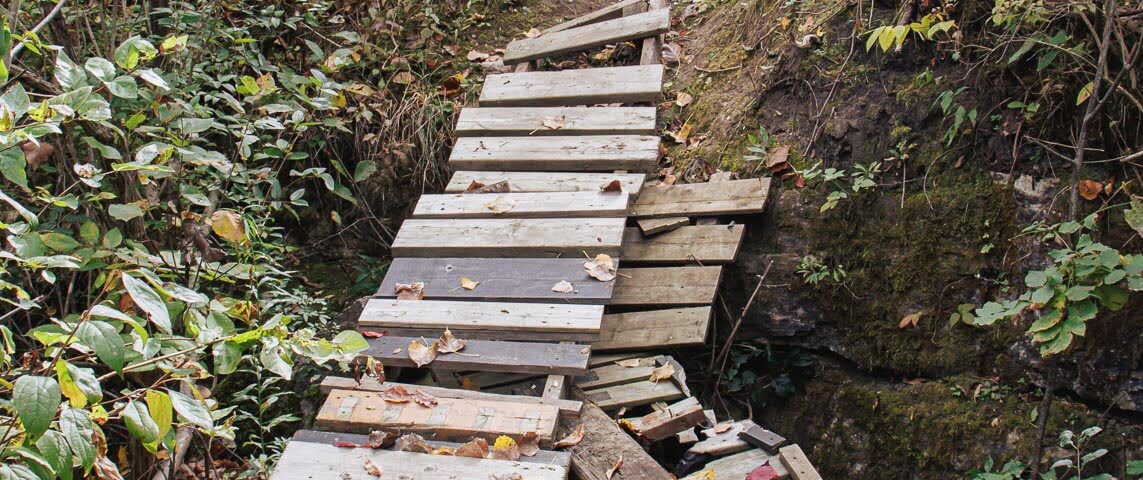Much of my life has involved taking calculated risks. From clambering around the school roof collecting lost balls as a kid, to free climbing small cliffs in my early teens, to parasailing above the Mediterranean off the shore of Ibiza as an adult, and skydiving as an old man on my wife’s birthday. Getting out of my comfort zone has book ended most of the memorable experiences of my life. And that includes today.
This scene might not seem like one about which to worry yourself. But I apply the same risk assessment process to every situation. To me, it’s become second nature to assess a scene at a glance.
That is clearly a man-made bridge. It covers a natural rocky break in the landscape. Two bridges, the left one clearly the more recent, presumably added as a replacement for the broken one on the right. A drop of around six feet onto sharp edges. An uphill slope, vertical angle around thirty to forty degrees. Looks like it might bear the 190-pound weight of a man north of sixty. Should be safe.
But that man is wearing a 40-pound backpack. His legs are no longer young, and he has had two strokes and two heart attacks. That makes him a little unsteady when tired, in the middle of a long hike. He is also a couple of kilometres from civilization. As he has not seen another human for two hours it’s reasonable to assume that even the loudest scream will go unheard. And if that bridge snaps like the one before it, that could be a world of hurt. OK. What are my options?
Here’s my risk assessment. As a young man I would have bounded across in two strides, backpack and all. As a senior, could I even make the uphill, angled crossing on these old legs? Will those planks break under my weight, as those on the right hand bridge clearly did for someone before me? Impale an artery as my leg goes through a rotted plank? Even a broken leg, scraped shin, or buggered up ankle would not be fun, so far from other people and my car. And I didn’t fancy dropping onto those sharp rocks.
There are reasons I have taken so many risks over the years, yet remain vertical. Most important among them, I’m not particularly stupid. This is just common sense. It’s a pure thought exercise. “What if…?” I weighed my options. I could go around. Take time to find or make another route. Scramble through the ditch. But then I would have to climb out of it. None of these options seemed optimal.
So I Inspected The Bridge
The right far end was in mid air. The bridge has warped and twisted, lifting the right end point a good six inches from the floor. So this fifteen foot bridge would rock wildly, potentially pitching me to an unknown fate below. The safest line would be to step along the centre of gravity, in the middle of the three contact points. But that’s putting weight on the centre of the planks. Where planks break. I usually step on the rails, as they are the strongest points, just like walking the joists in an attic. Hmm. There were bushes to my left. Using their branches to steady myself against the entirely expected rocking of the bridge, I crossed, walking on the rails. They were still the strong points, and I trusted them more than the planks. The bridge, as expected, wobbled like crazy. So I crossed like an old man on what was indeed a very wobbly bridge. And reached the other side safely. As expected. Calculated risk. No sweat.
Because I routinely approach every situation as a calculated risk (a perfectly logical thing to do), rather than pitching off the bridge into an uncertain future, or breaking any bones, I made it safely across and survived to live another day. Objective achieved. Onward. I’ve done this and far worse, a time or two.
Of course, I had a plan for failure. Because I calculate that risk, too. How to fall, where to jump. I checked my cell coverage (good) and put it where it was safe and easy to reach in case of a fall. Just in case.
I kinda take things like this, pun intended, in stride. There are times when I have turned round. Found another way. Some would say, chickened out. But hey, I’ve jumped out of planes and swung from a rope a half mile in the air. I’ve thrown myself into real danger a few times, to help others. Doing instinctive risk assessments in real-time to calculate the odds of success. On such occasions the calculations are a little different, of course, but the principle is the same: Will this work? It’s more accurate to say, on those occasions when I turned away it was because I calculated the risks and decided my best course of action was to do something else.
Don’t become a statistic through bravado, or laziness, or life-threatening peer pressure. That’s a good way to end up hurt, or dead. It’s braver to say “No” and mean it. Do that which carries the best chance of success. Of achieving the goal at hand.
For me, it’s second nature. I often I take this approach when driving, crossing the street, or arguing with idiots. It’s all the same process. It works. Well.
And I’m still here.
